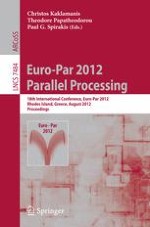This book constitutes the thoroughly refereed proceedings of the 18th International Conference, Euro-Par 2012, held in Rhodes Islands, Greece, in August 2012. The 75 revised full papers presented were carefully reviewed and selected from 228 submissions. The papers are organized in topical sections on support tools and environments; performance prediction and evaluation; scheduling and load balancing; high-performance architectures and compilers; parallel and distributed data management; grid, cluster and cloud computing; peer to peer computing; distributed systems and algorithms; parallel and distributed programming; parallel numerical algorithms; multicore and manycore programming; theory and algorithms for parallel computation; high performance network and communication; mobile and ubiquitous computing; high performance and scientific applications; GPU and accelerators computing.
